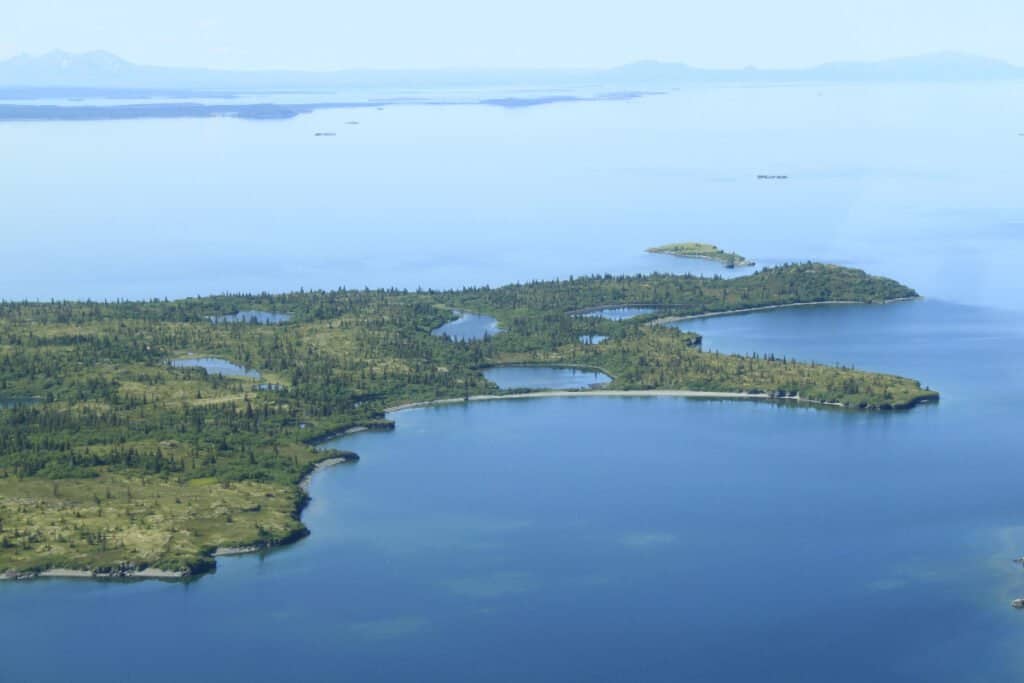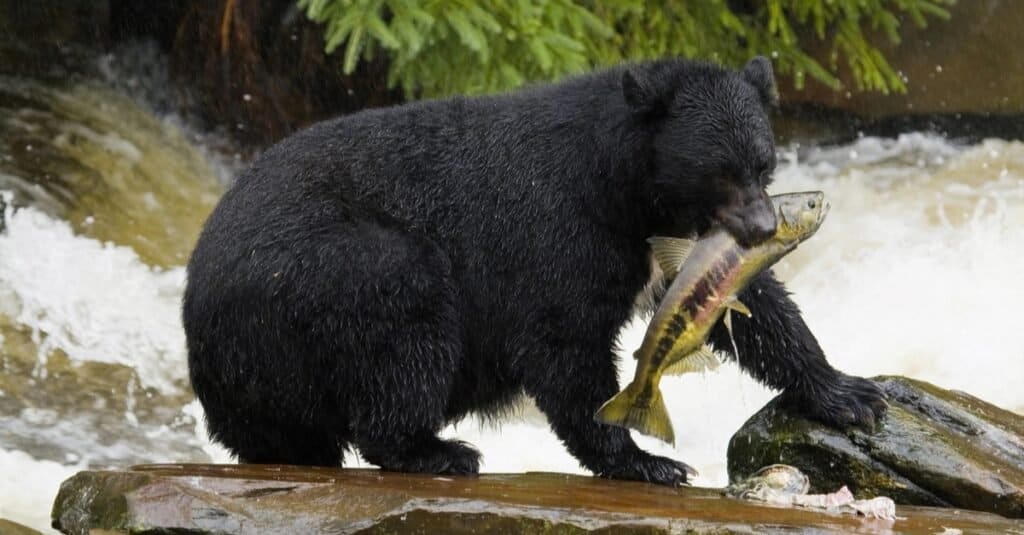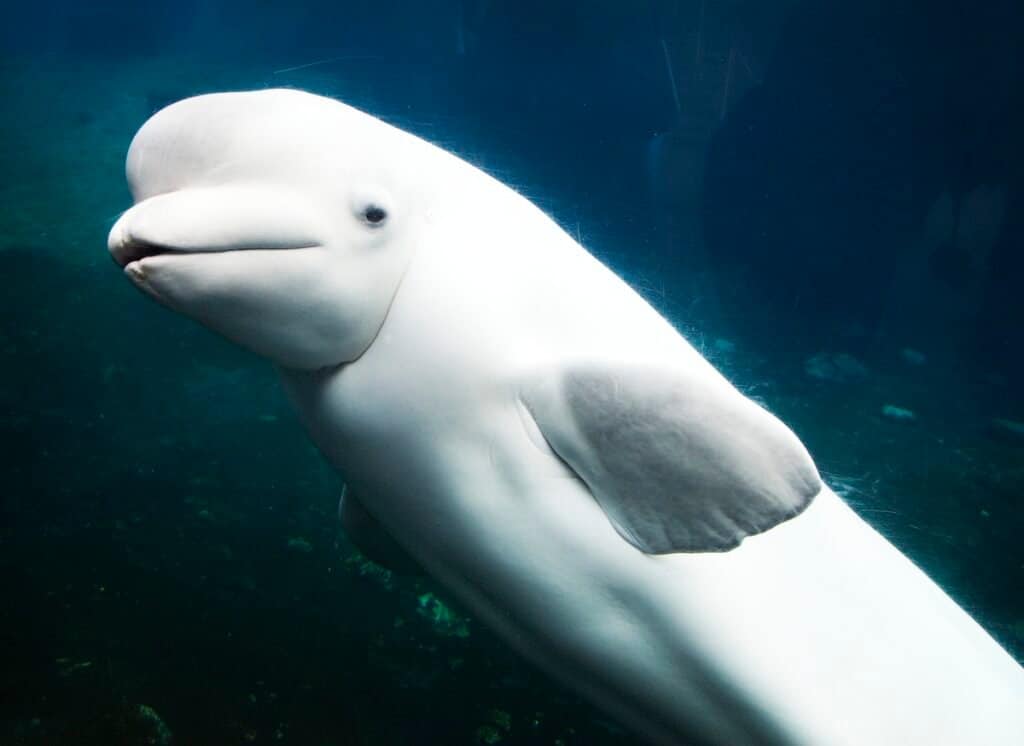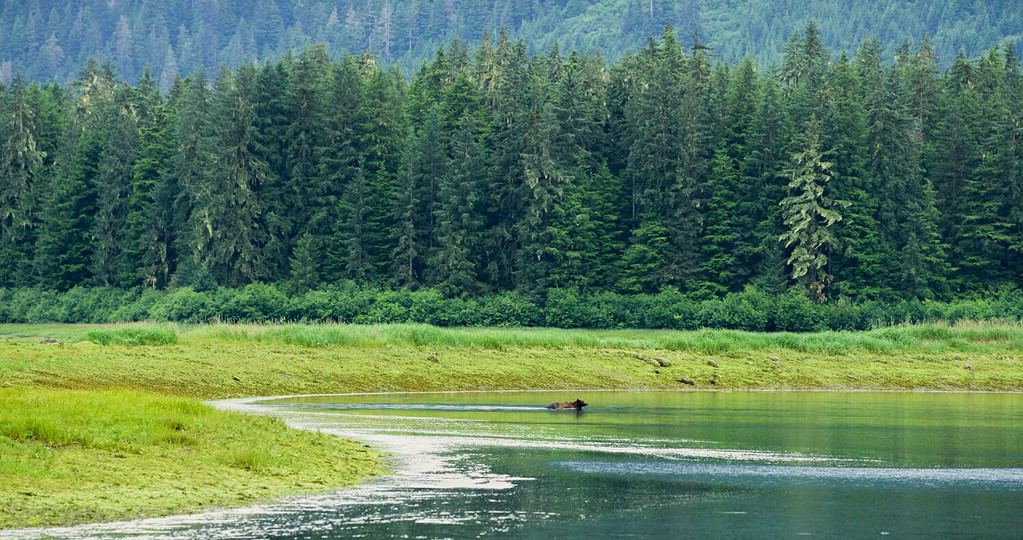Kvichak River is a large river approximately 80 kilometers long. It’s famed for a massive salmon run and said to have some of the cleanest water around, so what lives in the Kvichak River, and is it safe to swim in? This article examines its wildlife and whether or not visitors should get in the water.
Where Is Kvichak River?
Kvichak River is situated in southwestern Alaska, U.S., in the Bristol Bay watershed, approximately 250 kilometers from Anchorage. Just northwest of Katmai National Park and Reserve, most of this river is federally owned or owned by native individuals.
It rises in Lake Iliamna (Alaska’s largest freshwater lake) and runs to Kvichak Bay, which is a Bristol Bay arm on the Alaska Peninsula. Used as a shortcut between Cook Inlet and Bristol Bay, it’s possible to boat the entire length.
Igiugig and Levelock native communities both live on and fish from its length. It’s named Kvichak, meaning “From” or “To great water.”

Kvichak River rises in Iliamna Lake and runs to Bristol Bay.
©Nessie91/Shutterstock.com
What Animals Live in the Kvichak River?
Kvichak River is best known for its epic salmon and top-class fishing. Here are the sport fish swimming in its waters.

Kvichak River is known for its epic annual salmon migration.
©emperorcosar/Shutterstock.com
Salmon
Many salmon species inhabit the Kvichak River. From mid-June to the end of July, king salmon and sockeye salmon pass through on migration. The chance to witness and catch these fish is worth millions of dollars to the local economy.
The largest and most sought-after Pacific salmon is the king salmon, but you might know it as the chinook or blackmouth. It’s large, and on the Kvichak River, it reaches up to 60 lbs, according to angler reports. This salmon migrates from its hatching place in freshwater to saltwater to grow, returning to freshwater to lay eggs and die. Its route passes straight through the Kvichak River.
Sockeye salmon, sometimes called red salmon, also migrate through the Kvichak River in the world’s largest sockeye run. During spawning, their skin turns bright red. Typically, they measure up to 2.5 feet and weigh up to 15 lbs.

Sockeye salmon annually migrate along the Kvichak River to the ocean.
©Sergey Uryadnikov/Shutterstock.com
Rainbow Trout
Rainbow trout measuring 7-12 inches long and up to 8 lbs inhabit the Kvichak River. These attractive fish have multi-toned colors, including a pink-red stripe and blue, green, or yellow bodies with black spots. Their color shines in clear waters, and because the Kvichak is crystal clear, its rainbow trout practically glow.
Carnivorous rainbow trout feed on insects, and small fish like minnows, but they’ll eat pretty much anything in the water if they can swallow it whole.
Arctic Grayling
Arctic grayling average 10-14 inches in the Kvichak River and weigh 4 lbs. They’re very popular with fly fishers. It’s considered one of the most important sport fishing species and a subsistence food for native Alaskans.
These omnivores eat whatever they find in the river, including algae, vegetation, crustaceans, smaller fish, and insects. They spawn in rocky streams, and when adults swim into the Kvichak River’s depths to start their adult lives.
Dolly Varden
Not a country and western singer, but a species of char in the Kvichak River that’s hugely popular with anglers because it’s aggressive and fun to catch. Anglers suggest using in-season flies for bait because they’re also crafty.
This fish is olive-green to gray with a white belly and yellow-pink flank spots, and there are two frequently seen species:
- Dwarf: measures 3-6 inches (usually found near small headwater streams)
- Regular: up to 24 inches
Arctic Char
Arctic char is the northernmost freshwater fish. They have dark gray or brown bodies with a red or yellow belly and are easily confused with salmon or trout species. They migrate annually between rivers and oceans to spawn, laying eggs in the freshwater Kvichak River.
These formidable fish can live in ice-covered lakes and are far from fussy eaters, picking up vegetation, crustaceans, smaller fish, and insects wherever they find them.
Northern Pike
Northern pikes arrive in the Kvichak River from Mid-July to August, much to the delight of anglers who love to hook this feisty and aggressive gator-like fish.
Known as just pike or “water wolves” throughout North America and Europe, they have elongated heads with prominent teeth to catch fish, insects, waterfowl, and unfortunate mammals falling in the water. Very little other than humans and bears prey on these dangerous fish.

Northern pike are aggressive carnivorous fish in the Kvichak River.
©bekirevren/Shutterstock.com
Other Animals in the Kvichak River
So, other than incredible, highly sought-after fish, what other animals inhabit these clean, cold waters?
Snakes
Snakes do not live or hunt in the Kvichak River, it’s just too cold for them and for a large part of the year, there’s little sunlight. Alaska is snake-free.
Orca
Killer whales live in Bristol Bay and feed on the epic salmon run we’ve discussed. Witnesses have spotted them chasing salmon up to the Kvichak River mouth. Orca chase salmon and beluga whales up the Nunshagak River, so it’s not unknown for them to move into fresh waters.
These fearsome 25-30 feet long predators are the largest member of the dolphin family, and they live in family member pods that hunt and navigate, sometimes in complete darkness, using clicks and whistles. It’s easy to identify an orca by its black back, white eye patch, and triangular dorsal fin.
Beluga Whales
White beluga whales reach 12 feet in length and boast a 5-inch deep layer of blubber, that’s more than their porpoise and dolphin relatives, to cope with cold water. They’re toothed whales that live and travel in groups up to 1,500 miles to spend summer in eastern Canada.
Beluga whales feast on migrating salmon, and they’re known to travel upriver to continue the meal. It’s rare, but beluga whales are spotted in the Kvichak River.

Beluga whales’ five-inch layer of blubber keeps them warm in arctic waters.
©Carol M Highsmith / CC0 1.0, Rawpixel – License
Harbor Seals
Harbor seals inhabit Bristol Bay, and Alaskan native hunters report sightings along the entire length of the Kvichak River up to Iliamna Lake.
Also known as common seals, these mammals breathe air and dive up to 20 minutes at a time to catch mussels, fish, clams, and crustaceans. It’s easy to recognize a harbor seal from its round head, big dark eyes, and spotty gray coat. They often haul themselves onto the shoreline for a rest in the sun.
Animals That Live Near Kvichak River
The Kvichak River is a pristine ecosystem that’s renowned for its wildlife. Not only do epic fish and mammals inhabit the water, but some incredible animals also live in the surrounding arctic tundra, including 40 terrestrial animals and 190 bird species. They include:
- Caribou
- Grizzly bear
- Brown bear
- Moose
- Lynx
- Mink
- Otter
- Fox
- Bald eagles
- Wolverines
- Porcupines
- Black bears
- Beavers

Several bear species, including brown bear, catch salmon from the Kvichak River.
©twabian/Shutterstock.com
Is the Kvichak River Polluted?
There’s very little pollution in the Kvichak River, and it’s considered one of the cleanest and most pristine environments on Earth. Its clear waters provide habitats, food, and drink to hundreds of animal species. However, locals and supporters have vociferously protested their disapproval of the proposed open-pit gold and copper mine: Pebble Mine, whose proposed site is upstream of the Kvichak, to keep the area safe.
Is It Safe to Swim in?
While there’s little pollution in the Kvichak River, it is freezing, and strong currents pose a danger to most swimmers. Its remote, rugged location is an issue too. If swimmers get into trouble, there’s little infrastructure or emergency support nearby.
There’s also the potential for a stray beluga or orca to come close if you’re swimming near Bristol Bay. On the shoreline, predators like bears may notice.
Recap: What’s in the Kvichak River, and Is It Safe to Swim In?
Kvichak River in Alaska is an epic ecosystem home to diverse fish, mammals, and birds. Its pristine waters make it a paradise for arctic animals, anglers, and conservationists.
It isn’t prohibited, but swimming in the cold, strong-current Kvichak River is not encouraged. Even in the summer, the frigid waters can cramp up and overpower the most experienced water lovers.
The photo featured at the top of this post is © SevenMaps/Shutterstock.com
Thank you for reading! Have some feedback for us? Contact the AZ Animals editorial team.






